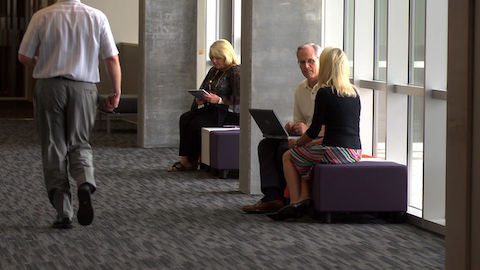K-State Olathe: International Animal Health and Food Safety Institute
Learning built on collaboration
Olathe, Kansas, US
Download PDF (728.8 KB)
Case Studies
Case Study: K-State Olathe - International Animal Health and Food Safety Institute
Crafting an environment that supports collaboration between academia, healthcare, and industry.
Animal health and food safety are major industries in Kansas—and in the world. They are also a primary focus of Kansas State University, a long-time leader in these fields of research.
In 2004, Kansas State University began making plans to expand with the creation of the Kansas Bioscience Park in Olathe. The new campus would provide a much-needed bridge connecting education directly with global industry in the animal health corridor, which stretches from Manhattan, Kansas to Columbia, Missouri. With Olathe at the core, the region accounts for more than one-third of the $19 billion animal health market worldwide.
When work began on the $28 million, LEED certified Silver, International Animal Health and Food Safety Institute, it was groundbreaking in more ways than one: it would be the first higher education facility supported by a local tax, and the ongoing tax support would make it equivalent to one of the country’s largest endowments ever to a higher education public institution initiative.
From the start, it was all about bringing people together, with a goal of not only expanding educational opportunities, but boosting economic growth as well.
Supportive Environment
The vision was to create a supportive environment where grad students and faculty work side by side with scientists, health professionals and others in the industry to conduct research, explore new technology, share information, and learn from one another. Overall, it would be about one-third classroom space, one-third laboratory, and one third public/meeting space.
The university contracted with DesignSense, a strategic project management company, to facilitate the building’s development. Using a “performance-based design” approach—where the owner does not rely on plans and specifications to describe the scope of the project, but focuses on the problems to be solved and leaves the solutions to 360 Architecture/Weitz Construction, the design/build team, to work out—set the stage for the entire process.
The International Animal Health and Food Safety Institute was envisioned as a blend of educational and corporate environments. That made it an ideal project for Herman Miller, where years of performance-based research show many commonalities in college and corporate settings. In the business world and on college campuses, people sometimes need to work alone and sometimes work together; they rely heavily on technology; they routinely give presentations and reports, share data with one another, and so on. Consequently, furniture needs for both are similar, too.
Collaboration From Day One
As if mirroring the building’s intent, the creation of the Institute itself was also based on teamwork. As Marvin Manlove of 360 Architecture states, “It’s a complex world out there; we can’t know everything, so we reach out to companies like Herman Miller and its dealership, the John A. Marshall Company, to bring ideas to the table. From the very start, this was a very collaborative effort, and I believe that was one of the things that made it so successful.”
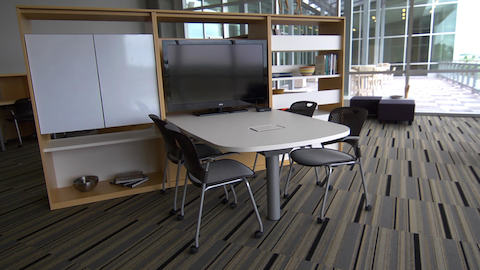
Canvas Group components give people the option of working alone or with others in the Cat’s Pause lounge area.
Dan Richardson, CEO of the Olathe campus, who headed the project for the school, agrees. “Bringing the furniture team in early in the process was critical,” he says. “It gave us the opportunity to do it the right way, not the standard way.”
Richardson adds that it was somewhat challenging because the building was a totally new concept and so broad in scope, it was difficult to identify specific end users. In fact, he says, “We wanted it to be adaptable to all kinds of users. The Herman Miller team clearly understood what we were trying to achieve. It’s all about creating spaces that support the way students learn and people interact.”
Of course, learning today happens everywhere from libraries to lounges, just as work happens everywhere from corporate cafes to conference rooms.
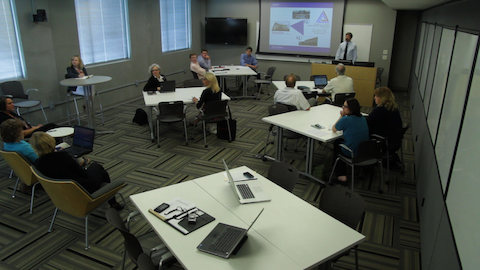
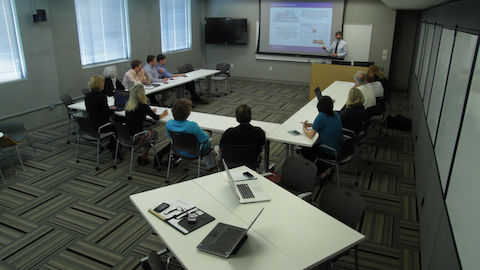
Flexibility was key in designing spaces; Everywhere tables and Caper chairs can be quickly and easily rearranged to accommodate different teaching or meeting needs.
Function Driving Form
So it was more a case of function driving form. Talking about the Herman Miller/John A. Marshall Company team, Richardson went on to say, “They were like the ‘Imagineers’ at Disney: they’d talk to us about what we needed functionally, then they’d bring back things we could react to, and that’s how we worked.”
John A. Marshall Company designer Erin Compton chose carefully from the long list of Herman Miller products, knowing the furnishings would need to be flexible and adaptable, filling spaces large and small to accommodate both individuals and groups.
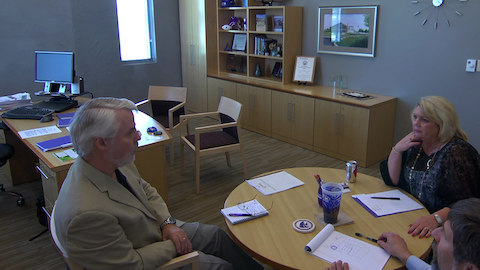
Geiger casegoods give the CEO’s office a contemporary, professional look.
Herman Miller’s Canvas Office Landscape System was an ideal place to start. With its holistic approach, it supports individual workers and teamwork/collaboration with everything from technology to storage.
Before selecting products for the administrative areas, the John A. Marshall Company used Herman Miller’s Mock-up Program to create workstations and a private office, complete with Mirra Chairs, for the employees to try out. “That was one of the most important steps,” says Richardson. “Showing people a picture is one thing, but when you can physically sit at a workstation and turn around to reach for something, that’s when you really know if you like the set up or not.”
Multiple Solutions
The Canvas Office Landscape Group-Based collection and other Herman Miller products provided numerous freestanding solutions for what’s called the “Cat’s Pause” lounge area, a space for meetings or for students can hang out between classes.
“The Canvas Group pieces were great for this space because they have so many desirable features,” says designer Erin Compton. “For example, the boundary screens can be made of tackable fabric or writable surfaces, making them a functional tool for meetings. And the Team Wall Technology Module not only provides easy access to power and data, but also allows users to wirelessly share their computer screens with others. The shelving is a nice touch because it gives people a place to put their bags and other items when they come in.”
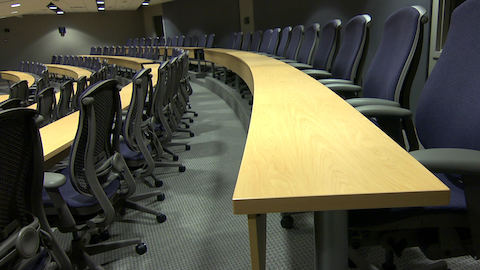
Affordability and comfort made Celle seating an ideal solution for the forum.
For spontaneous gatherings, nothing beats Everywhere Tables, which are on wheels and fold up for easy storage. “Put them with some Caper Chairs on casters and you’ve got a flexible classroom wherever you need it,” says Compton.
“Those were the little details we really paid attention to,” says Richardson.
Cohesion And Harmony
The furniture gives a cohesive look throughout the entire facility, creating a harmonious aesthetic for those who come to work and learn there. Compton points out that individual pieces may be moved around to different parts of the campus later, so it’s important that it all works well together.
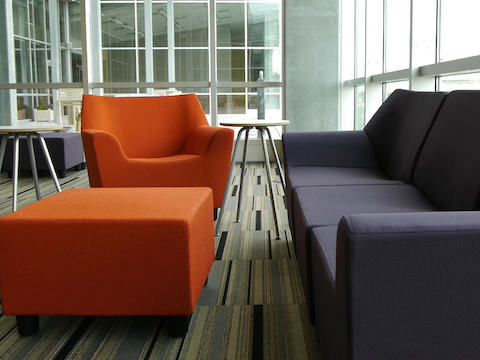
Herman Miller’s Swoop collection provides comfortable lounge seating and handy tables wherever needed in the multi-purpose facility.
Since opening in 2011, the programs offered on campus have attracted groups ranging from graduate students to international animal vaccine experts to consumer taste-testing companies to start-up food businesses.
The campus is not just limited to higher education, either; programs and curricula for K-12 students and teachers are helping prepare future college students and entrepreneurs, giving them a taste of what’s ahead.
There are also public spaces for people to hold or attend catered events in a building they can proudly call their own. (Partially funded with tax money, it truly is.) Richardson also notes the importance of achieving LEED Silver certification. "It not only demonstrates our commitment to a sustainable, environmentally friendly campus, but to being good stewards of the land given to us by the City of Olathe."
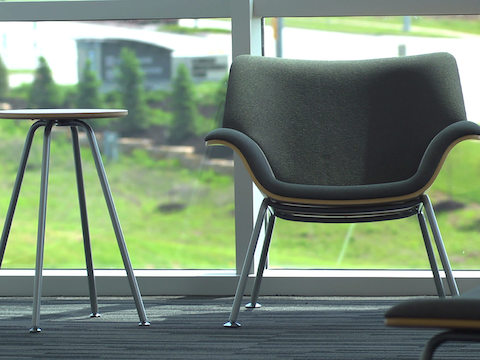
A wide variety of movable seating and small tables provide plenty of options for working throughout the building.
Herman Miller Representative Linda Atha feels some of the building’s success can be attributed to the fact her team was brought in early. “We have research and experience beyond furniture—from sustainability to technology to new ways of learning—that we can really help make the whole process smooth, from start to finish.”
“If [Herman Miller] hadn’t met with us early on to understand our needs, it might have been much different scenario,” observes Richardson. “We wanted the best value for our dollar, not the cheapest solution, and that required lots of discussion beforehand.”
In the end, he says, “I feel like we really got what we wanted, and we’ve had nothing but positive comments from everyone who comes here. So it’s been a very rewarding experience. Best of all, our campus is doing exactly what we envisioned.”
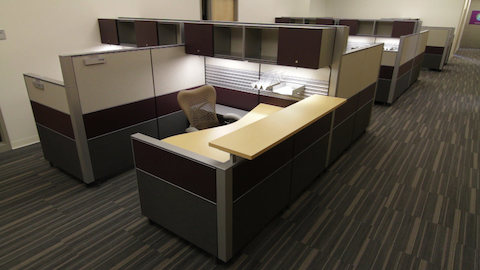
Canvas Office Landscape gives the administration area a clean, contemporary aesthetic.
